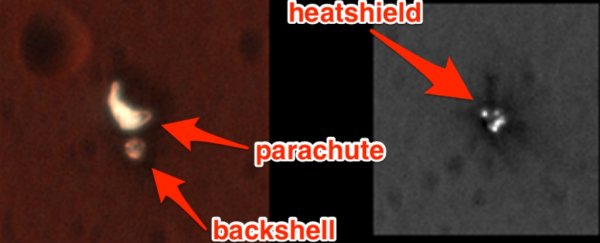When the European Space Agency (ESA) lost contact with half of its ambitious ExoMars 2016 mission - the Schiaparelli lander - on 19 October, the probe was falling from the Martian sky like an incendiary bomb.
Previous photos showed the crash site in black-and-white, but new colour photos paint an even clearer view of Schiaparelli's final moments.
The 8-foot-wide (2.40-metre-wide) probe survived a harrowing atmospheric reentry and a jerky parachute deployment during its 6-minute descent.
However, an unknown computer glitch led to its doom. Schiaparelli was supposed to fire up its rocket engines for about 30 seconds, then gently plop onto the surface of Mars. They only fired for 3 seconds.
The result? The probe hit the ground at more than 185 miles per hour (298 kilometres per hour) with a belly full of fuel, catastrophically exploded, and left a sooty crater.
The ESA is getting a better and better view of the crash site on Mars using NASA's Mars Reconnaissance Orbiter (MRO), which keeps passing over and zooming in on the carnage.
Until now, those images have all been in black-and-white.
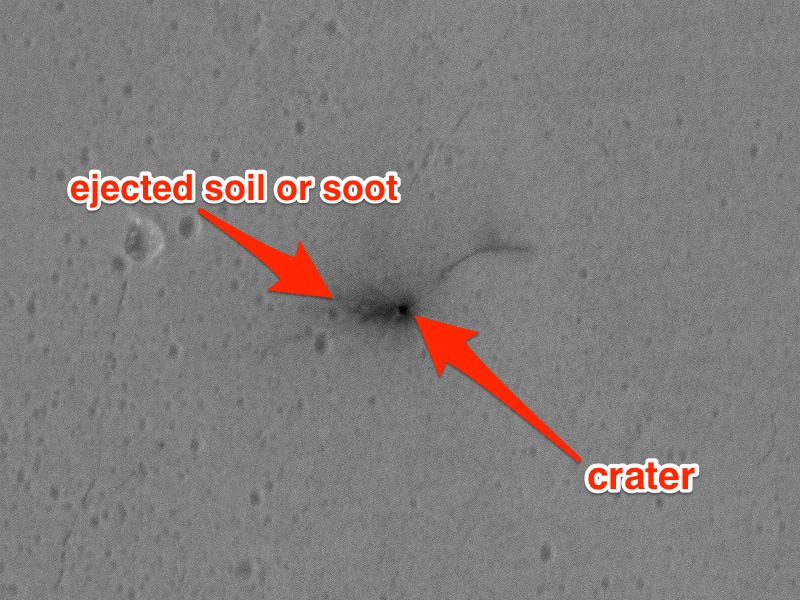 NASA/JPL-Caltech/University of Arizona/Business Insider
NASA/JPL-Caltech/University of Arizona/Business Insider
On 1 November, however, MRO took a photo through three filters with its High-Resolution Imaging Science Experiment (HiRISE) camera, allowing image technicians on Earth to give the image red, blue, and green values - and bring the crash site into full focus and colour.
In the new colour image below, you can make out details that were previously hidden in the low contrast of black-and-white images.
"For example, a number of the bright white spots around the dark region interpreted as the impact site are confirmed as real objects - they are not likely to be imaging 'noise' - and therefore are most likely fragments of Schiaparelli," the ESA said in a November 3 press release.
Basically, the white spots - now visible in the colour image - appear to be chunks of the blown-up probe:
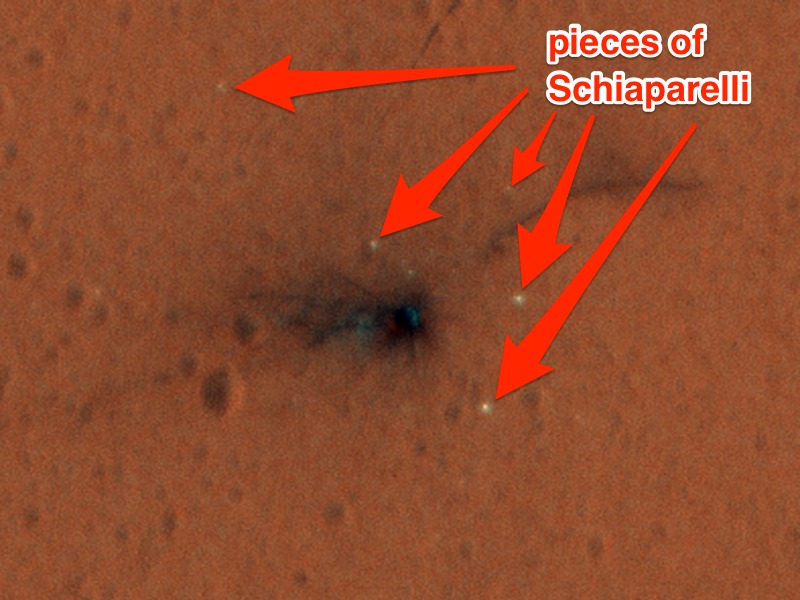 NASA/JPL-Caltech/University of Arizona/Business Insider
NASA/JPL-Caltech/University of Arizona/Business Insider
To get a sense of scale, the main dark splotch spans about 80 feet (24 metres) - about the length of an Airbus A380 aeroplane or two city buses.
The curved dark streak at the upper right of the image is between 110 and 120 feet (33 and 36 metres) long, which is more than twice as long as two semi trucks.
MRO has also taken enough high-resolution images to better resolve the lander's parachute and heatshield.
The HiRISE team animated a handful of images from October 25 through November 1, and they show the probe's parachute flapping in the wind, anchored in place by its heavy backshell.
This human relic may billow and flutter in the light Martian breeze for centuries, unless, of course, a future Martian colonist comes to pick it up and put it into the Elon Musk Museum of Mars:
The ESA says it will be looking more closely at the heatshield's landing site, since that may offer some clues as to what went wrong and when.
It hasn't moved, so they hope to construct a stereo-3D image to check its orientation and other details:
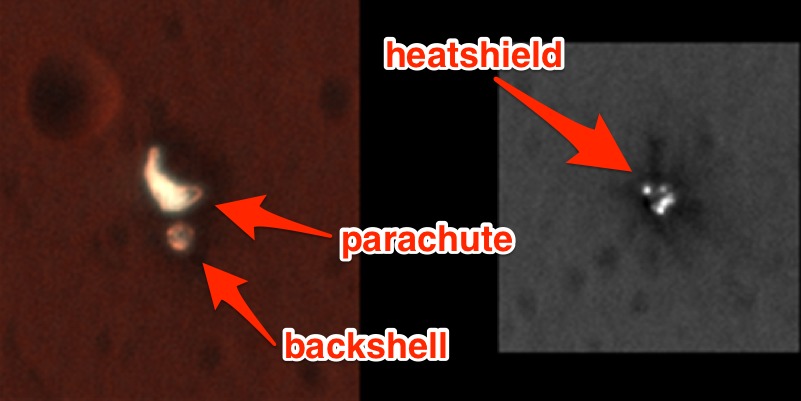 NASA/JPL-Caltech/University of Arizona/Business Insider
NASA/JPL-Caltech/University of Arizona/Business Insider
"Further imaging is planned in about two weeks, and it will be interesting to see if any further changes are noticed," the ESA said.
The space agency has launched an investigation into the failed mission.
Dissecting a disaster
According to the last bits of data it beamed to Earth, the 8-foot-wide (2.4-metre-wide) probe survived a harrowing atmospheric reentry at 13,000 miles per hour (20,921 kilometres per hour), popped off its heat shield, and deployed a parachute.
But Paolo Ferri, the ESA's head of mission operations, said on 19 October that something "unexpected" occurred when Schiaparelli was supposed to fire up its thrusters and gently plop onto the surface of Mars.
Engineers have worked day in and day out since they lost contact with the probe to deduce what happened. Their best guess so far? A computer glitch made the robot think it was close to the ground when it was actually a mile high.
MRO helped confirm this conclusion by taking a photo of Schiaparelli's suspected landing site a day after it was supposed to arrive.
The animation alternates between two views of the site: one photographed in May 2016, and the second on October 20:
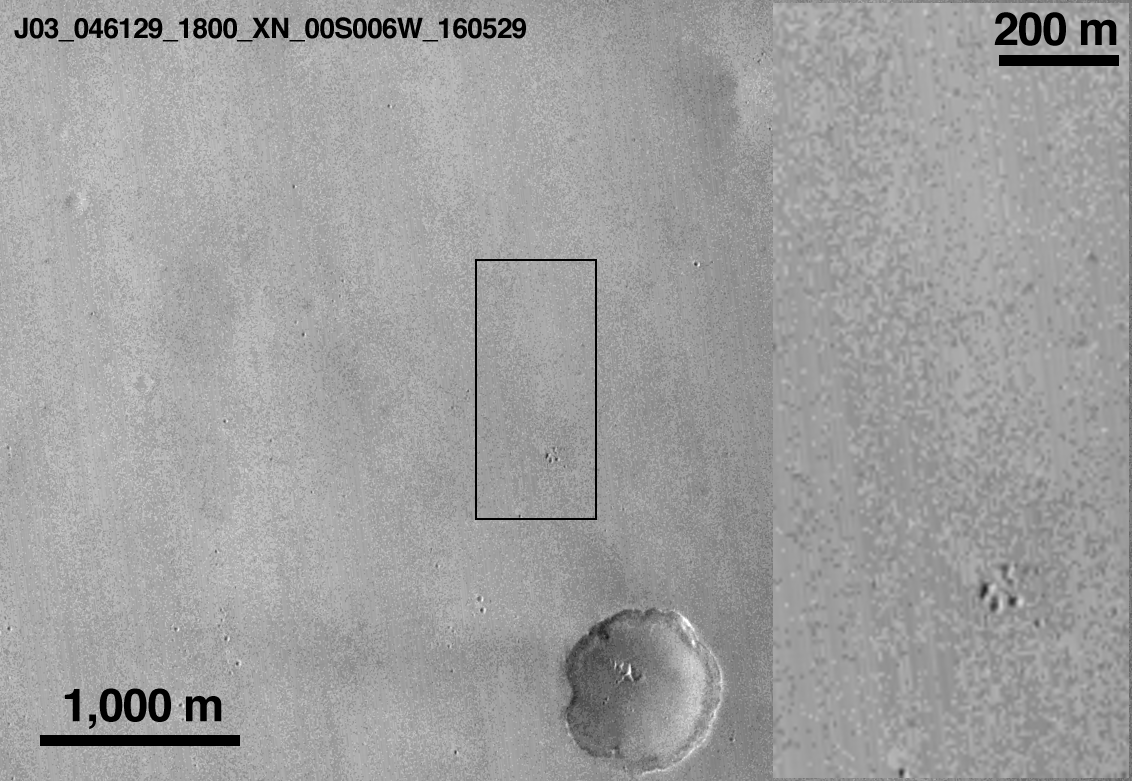 NASA/JPL-Caltech/University of Arizona
NASA/JPL-Caltech/University of Arizona
The right pane is a zoomed-in view of the site. It clearly shows a dark spray of material that spans 130 feet (39 metres), roughly a 13-story building on its side - a sooty black stain that used to be Schiaparelli.
An October 25 image from MRO more clearly shows the locations of the lander's crash site, heat shield, and parachute and backshell:
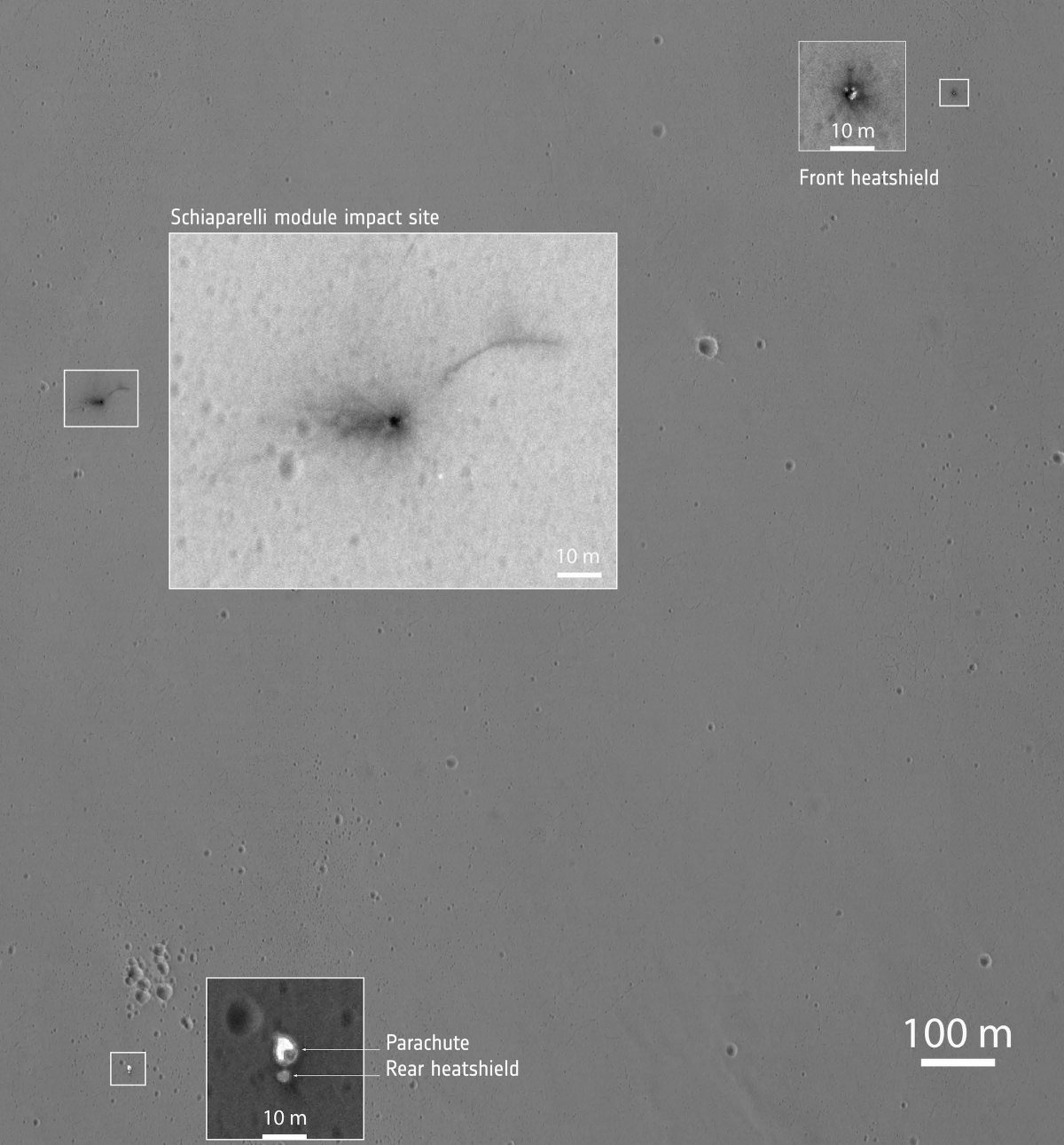 NASA/JPL-Caltech/University of Arizona
NASA/JPL-Caltech/University of Arizona
Mars is hard
Had Schiaparelli landed, it would have been the ESA's first spacecraft to safely reach the surface of the red planet. Unfortunately, these images mean the probe has joined a growing graveyard of failed Martian spacecraft.
For Russia, which collaborated with the ESA on the mission, Schiaparelli is the nation's seventh failed Mars landing - though it put two satellites into Mars' orbit while it was still the Soviet Union.
Fortunately, Schiaparelli is just one-half of the ExoMars 2016 mission; the other half is Schiaparelli's mother ship, the Trace Gas Orbiter. The ESA said the orbiter safely entered into Mars orbit, which means its task of sniffing for methane on Mars - a potential sign of microbial life - can begin.
The lander's mission was designed as a precursor to a more ambitious rover mission planned for 2020, so it's more of an engineering proof-of-concept than a science mission. Still, the mission failed, and officials were quick to downplay the loss.
"We should remember this landing was a test," Ferri said on October 20. "And as part of the test, you want to learn what happened," no matter the outcome.
Before Schiaparelli, humanity tried 18 times to touch Mars with penetrators, landers, and wheeled rovers. Only eight missions have succeeded.
The last time the ESA tried to land a probe on Mars, in 2003, it failed. Its Beagle 2 lander successfully jettisoned from an orbiting spacecraft. Aside a final signal before its descent, however, the robot never contacted Earth again.
It wasn't until January 2015 - more than a decade later - that NASA's MRO found and photographed the dead rover in a satellite image. A subsequent investigation found that its solar panels had failed to deploy, so it never mustered the energy to phone home.
Had the new Schiaparelli probe survived, it would have also taken pictures of its descent and attempted to measure Mars' electric field for the first time and make other limited scientific observations.
May it rest in pieces.
This article was originally published by Business Insider.
More from Business Insider:
